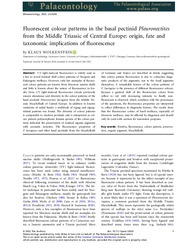Fluorescent colour patterns in the basal pectinid Pleuronectites from the Middle Triassic of Central Europe: origin, fate and taxonomic implications of fluorescence
DOI: https://doi.org/10.1111/pala.12625
Persistent URL: http://resolver.sub.uni-goettingen.de/purl?gldocs-11858/10454
Persistent URL: http://resolver.sub.uni-goettingen.de/purl?gldocs-11858/10454
Wolkenstein, Klaus, 2022: Fluorescent colour patterns in the basal pectinid Pleuronectites from the Middle Triassic of Central Europe: origin, fate and taxonomic implications of fluorescence. In: Palaeontology, Band 65, 5, DOI: 10.1111/pala.12625.
 |
Dokument öffnen: |
UV light‐induced fluorescence is widely used as a key to reveal residual shell colour patterns of Neogene and Palaeogene molluscs. However, only few examples of fluorescent colour patterns are known from Mesozoic marine shells and little is known about the nature of fluorescence in fossils. Here, UV light‐induced fluorescence reveals previously unseen abundance and diversity in the colour patterns of the basal pectinid Pleuronectites laevigatus from the Middle Triassic Muschelkalk of Central Europe. In addition to known variations of radial bands, a multitude of zigzag and zigzag‐related patterns was found. The diversity of colour patterns is comparable to modern pectinids and is interpreted as colour pattern polymorphism. Raman spectra of the colour patterns indicated the preservation of residual organic pigments with aromatic moieties. The fluorescence properties of P. laevigatus and other basal pectinids from the Muschelkalk of Germany and France are described in detail, suggesting that colour pattern fluorescence is due to colourless diagenetic products of the pigments, not to the fossil pigments themselves. A remarkable feature of the colour patterns of P. laevigatus is the presence of different fluorescence colours. Because a gradual shift of the fluorescence colour from yellow to red with decreasing intensity to finally non‐fluorescent is observed, which correlates with the provenance of the specimens, the fluorescence properties are interpreted to reflect differences in diagenetic history. The results show that the fluorescence colour of fossil molluscs, especially of Mesozoic molluscs, may be affected by diagenesis and should only be used with caution for taxonomic purposes.
Statistik:
ZugriffsstatistikSammlung:
This is an open access article under the terms of the Creative Commons Attribution License, which permits use, distribution and reproduction in any medium, provided the original work is properly cited.

